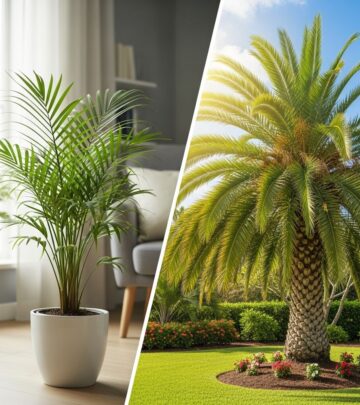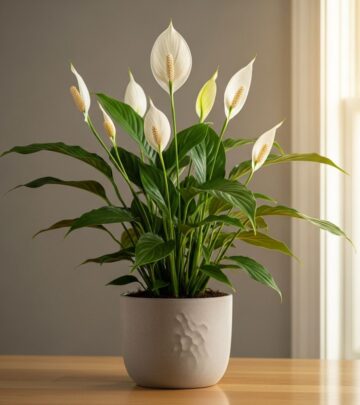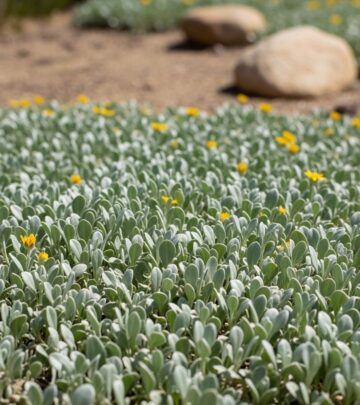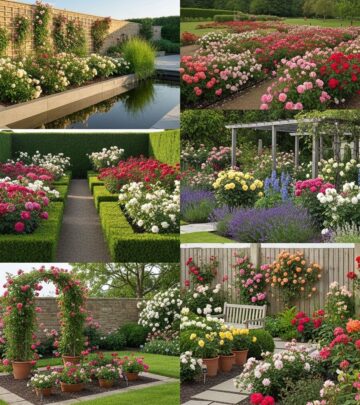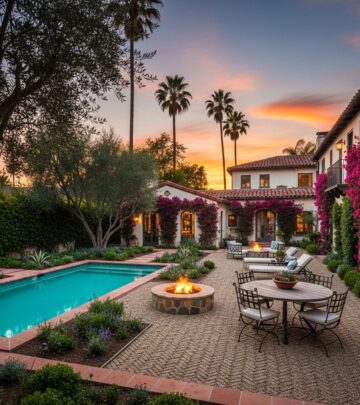English Garden Design Ideas: 4 Timeless Styles To Try
Transform your green space into a charming haven with classic style and graceful flair.
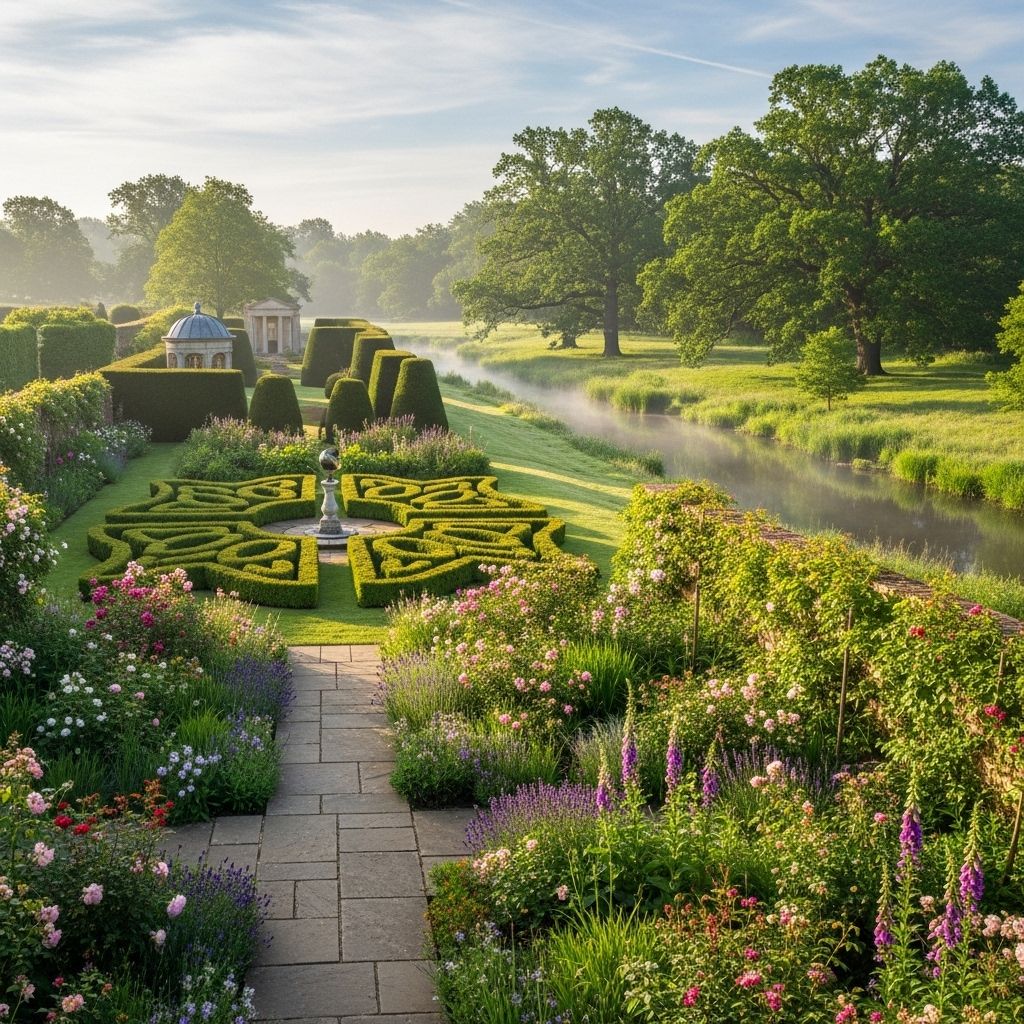
Image: HearthJunction Design Team
English Garden Design: Creating Timeless Outdoor Elegance
English gardens have captivated garden enthusiasts worldwide with their timeless charm, lush plantings, and harmonious design. These iconic landscapes range from formal elegance to cottage-style exuberance, offering inspiration for gardens of all sizes. In this comprehensive guide, we’ll explore the various English garden styles, their essential elements, and how you can incorporate this classic aesthetic into your own landscape.
Understanding the English Garden Tradition
The English garden tradition spans centuries of horticultural evolution, reflecting changing cultural values, design philosophies, and botanical knowledge. What makes these gardens so enduring is their perfect balance of artistry and nature—creating spaces that feel simultaneously designed and effortlessly natural.
English gardens typically fall into several distinct styles, each with its own characteristics and historical context. From the structured formality of Renaissance-inspired designs to the wild abundance of cottage gardens, these approaches offer something for every gardener’s taste and landscape situation.
Types of English Gardens
The Cottage Garden: Romantic Abundance
Cottage gardens emerged from the practical needs of rural English households, combining ornamental plants with edibles in a delightful, seemingly unplanned profusion. These gardens are characterized by their dense, abundant plantings, informal layout, and romantic atmosphere.
Key features of the classic English cottage garden include:
- Dense, overflowing planting beds with minimal visible soil
- A mix of perennials, annuals, herbs, and edible plants
- Climbing plants on trellises, arbors, and walls
- Curving pathways rather than straight lines
- Traditional materials like brick, gravel, and weathered wood
- Self-seeding plants that create naturalistic drifts
The cottage garden embraces a certain controlled chaos, with plants allowed to spill over pathways and intermingle freely. Classic cottage garden plants include hollyhocks, foxgloves, delphiniums, lavender, roses, and herbs like rosemary and thyme.
The Formal English Garden: Structured Elegance
Formal English gardens draw inspiration from Renaissance Italian and French designs but with a distinctly English sensibility. These gardens emphasize symmetry, geometric patterns, and clearly defined spaces, creating a sense of order and architectural harmony.
Distinctive elements of formal English gardens include:
- Symmetrical layouts with a central axis
- Meticulously clipped hedges and topiary
- Geometric parterres and knot gardens
- Well-defined garden rooms separated by walls or hedges
- Water features like reflecting pools and fountains
- Statuary and ornamental elements at focal points
Plants in formal gardens are selected for their ability to maintain clean lines and defined shapes. Boxwood, yew, and privet are essential for hedging, while structured perennials and roses fill the beds with color while respecting the overall geometric framework.
The Woodland Garden: Natural Serenity
Woodland gardens celebrate the subtle beauty of England’s native forests, creating tranquil spaces filled with shade-loving plants and naturalistic elements. These gardens excel at creating peaceful retreats and work beautifully in properties with mature trees.
Characteristic features of woodland gardens include:
- Dappled shade from canopy trees
- Layered plantings from ground covers to understory trees
- Meandering paths through naturalistic plantings
- Spring-flowering bulbs and ephemeral perennials
- Ferns, hostas, and other textural foliage plants
- Natural materials like stone, logs, and leaf mulch
The woodland garden shines in spring with displays of bluebells, primroses, and wood anemones, followed by the rich foliage textures of summer and the subtle colors of autumn. This style works particularly well in properties with existing mature trees or shaded areas.
The Contemporary English Garden: Modern Tradition
Today’s English gardens often blend traditional elements with contemporary sensibilities, creating spaces that honor the past while embracing modern lifestyles and environmental concerns. These gardens may incorporate sustainable practices, native plantings, and streamlined design elements.
Modern English gardens frequently feature:
- Simplified color palettes with disciplined plant selections
- Prairie-style perennial plantings inspired by naturalistic design
- Sustainable practices like rainwater harvesting and composting
- Native plant species that support local wildlife
- Outdoor living spaces integrated with plantings
- Modern materials complementing traditional elements
Designers like Tom Stuart-Smith, Dan Pearson, and Sarah Price exemplify this contemporary approach, creating gardens that feel distinctly English while pushing the tradition forward into the 21st century.
Essential Elements of English Garden Design
The Importance of Structure
All English gardens, regardless of style, rely on good structural elements to create their distinctive character. This structure provides year-round interest and a framework that supports the more ephemeral seasonal plantings.
Key structural elements include:
- Hedges that define spaces and create garden rooms
- Paths that guide movement and create visual lines
- Walls, fences, or other boundary treatments
- Evergreen shrubs and trees that provide winter interest
- Fixed elements like pergolas, arbors, and garden buildings
- Hardscape features such as stone terraces and steps
This underlying structure is what allows English gardens to maintain their appeal throughout the seasons, even when flowering perennials have died back for winter.
The Art of Plant Selection
English gardens are renowned for their sophisticated plant combinations that create visual interest throughout the growing season. While specific plant choices vary by garden style, certain principles apply broadly:
- Layer plants of different heights to create depth and dimension
- Combine plants with complementary colors and contrasting textures
- Plan for succession of bloom from early spring through late fall
- Include plants with winter interest like seed heads and bark
- Consider foliage as carefully as flowers for lasting appeal
- Repeat key plants throughout the garden for visual cohesion
Classic English garden plants include roses, delphiniums, foxgloves, lavender, phlox, and peonies, but contemporary designers are expanding this palette with ornamental grasses, native species, and plants selected for climate resilience.
Creating Garden Rooms
A quintessential feature of larger English gardens is the concept of garden rooms—distinct spaces with their own character connected by paths, openings, or subtle transitions. This approach creates a sense of journey and discovery as visitors move through the landscape.
Garden rooms might include:
- A formal area near the house with structured plantings
- A kitchen garden with herbs and vegetables
- A woodland walk beneath mature trees
- A wildflower meadow area for pollinators
- A secluded seating area for quiet contemplation
- A water garden with aquatic plants
Even in smaller gardens, the principle of creating distinct zones with different moods and purposes can add depth and interest to the landscape.
Creating Your Own English Garden
Starting Small: English Garden Elements for Limited Spaces
You don’t need a grand estate to create an English-inspired garden. Even small spaces can incorporate key elements of this design tradition:
- Frame a garden entrance with climbing roses or an arbor
- Create a small herb garden with traditional plants
- Plant a mixed border with perennials and shrubs
- Add one well-chosen focal element like a birdbath or bench
- Use containers for seasonal displays of English garden flowers
- Install a small water feature for ambient sound
The key is selecting elements that will work in your space rather than trying to include everything. A well-designed small garden that honors English principles can be more successful than an overcrowded attempt to recreate Sissinghurst in a suburban lot.
Seasonal Considerations
English gardens are designed to provide interest throughout the year, not just during the summer flowering season. Consider how your garden will look in each season:
- Spring: Bulbs, flowering trees, and early perennials
- Summer: Peak flowering season with roses and perennials
- Autumn: Seed heads, berries, and fall foliage color
- Winter: Evergreen structure, interesting bark, and garden architecture
Planning for year-round interest ensures your garden remains engaging even during dormant periods. Remember that structure becomes particularly important in winter when deciduous plants have lost their leaves.
Maintenance and Care
English gardens require thoughtful maintenance to preserve their character while allowing for the natural evolution of plants. Key maintenance tasks include:
- Regular pruning of hedges and structural elements
- Deadheading to promote continued flowering
- Division of perennials to maintain vigor
- Seasonal cutbacks of herbaceous plants
- Ongoing weeding and mulching of beds
- Monitoring for pests and diseases
While English gardens may appear effortless, they require consistent care to maintain their distinctive character. However, many gardeners find these maintenance tasks deeply satisfying as they connect with the rhythms of the garden through the seasons.
Adapting English Garden Principles to Your Climate
One of the most important considerations when creating an English-inspired garden is adapting traditional designs to your local climate and conditions. England’s cool, moist climate differs significantly from many regions where gardeners seek to recreate this style.
Consider these adaptations for different climates:
- Hot, dry regions: Select drought-tolerant alternatives to traditional English plants; create more shade; emphasize structure over seasonal flowers; consider water-wise irrigation
- Cold northern areas: Choose hardier plant varieties; protect tender perennials in winter; focus on spring and summer display with strong winter structure
- Humid, subtropical areas: Select disease-resistant varieties; provide good air circulation; adapt plant spacing for faster growth; consider native alternatives to English classics
The most successful English-inspired gardens honor the principles and feeling of the tradition while embracing the realities of local growing conditions. Working with nature rather than against it results in more sustainable and resilient landscapes.
Frequently Asked Questions
Q: What’s the difference between English and French garden styles?
A: French gardens typically emphasize strict formality, symmetry, and geometric precision throughout the entire landscape. English gardens, while often incorporating formal elements near the house, transition to more naturalistic plantings further from the structure. English designs generally feel more relaxed and plant-focused, while French gardens prioritize architectural order and grand vistas.
Q: How can I create an English garden in a small space?
A: Focus on key elements rather than trying to include everything. Choose one style (cottage, formal, etc.) that suits your space; incorporate vertical elements like climbing roses or vines; use high-quality hardscaping materials; and select plants that perform multiple functions (structure, flowers, and fall color). Even a small mixed border or container garden can capture the essence of English garden style.
Q: Which plants are essential for an English cottage garden?
A: Classic cottage garden plants include roses (especially climbing and shrub varieties), foxgloves, delphiniums, hollyhocks, lavender, catmint, lady’s mantle, phlox, peonies, and herbs like rosemary and sage. Include a mix of perennials, biennials, and self-seeding annuals for the characteristic abundance. Don’t forget structural elements like small shrubs and ornamental grasses to provide year-round interest.
Q: How much maintenance does an English garden require?
A: English gardens typically require regular, thoughtful maintenance rather than intensive weekly care. Tasks include seasonal pruning, division of perennials every few years, deadheading during flowering seasons, hedge trimming, and ongoing weeding. The level of maintenance depends on your chosen style—formal gardens with clipped hedges and topiary require more frequent attention than more naturalistic designs.
Q: Can I create an English garden in a dry climate?
A: Yes, but you’ll need to adapt the principles rather than directly transplanting the plant palette. Focus on creating the structure and feeling of an English garden using climate-appropriate plants. Consider drought-tolerant herbs, Mediterranean plants, and native species that can create similar textures and forms. Emphasize hardscaping elements like paths, walls, and defined beds to establish the English garden framework while using water-wise planting strategies.
References
- https://www.gardendesign.com/ideas/
- https://www.monrovia.com/be-inspired/category/design.html
- https://thecontentpanel.com/blog-post-ideas/garden-landscaping-topics/
- https://www.provenwinners.com/learn/top-ten-lists/10-basic-elements-garden-design
- https://www.houzz.com/discussions/1421080/what-to-write-my-next-gardening-article-on
Read full bio of medha deb




